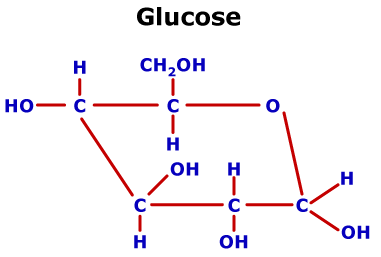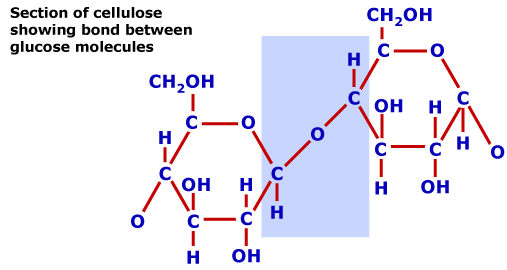Previous Page | Right click this page to print.
Carbohydrates
The second of the six nutrients is carbohydrates; often abbreviated CHO. Chemically, carbohydrates are composed of carbon, hydrogen, and oxygen. Carbohydrates are of plant origin. Carbohydrates are the primary component in livestock feeds and the resultant diet; however, there is no specific requirement for carbohydrates. Rather, carbohydrates function to provide the animal with: 1) an energy substrate; and 2) for animals that require fiber, fiber.
The simplest form of a CHO is a monosaccharide. Monosaccharides are often referred to as simple sugars. Examples of monosaccharides include glucose, fructose, and lactose.
Figure 2.3 illustrates the chemical structure of glucose.

Figure 2.4 and 2.5 illustrate the chemical structures of starch and cellulose, respectively.


Both starch and cellulose are composed of glucose units. The primary difference between the two polysaccharides is the linkage of their units. The glucose molecules in starch are linked via alpha linkages. The alpha linkages may be broken by both mammalian and microbial enzymes. In contrast, the glucose molecules in cellulose are linked via beta linkages. In contrast, the beta linkages may be broken by only microbial enzymes. The differential digestibilities of the linkages are the reason some species cannot digest nor utilize fibrous feedstuffs. It is important to repeat that it is the microbes in the ruminant and other herbivores that digest the fibrous feedstuffs; it is not the mammal. Feedstuffs high in starch include grains and feedstuffs high in cellulose include forages. Other carbohydrates include pectins and hemicellulose. Pectins and hemicellulose are only digested and utilized by microbes.
Significant differences exist between the carbohydrate digestion and absorption of nonruminants and ruminants. In the monogastric diet, starch is the primary carbohydrate. In the small intestine, starch is digested by pancreatic amylase in conjunction with other enzymes. The complex polysaccharides are completely digested to monosaccharides. The monosaccharides are readily absorbed into the bloodstream via the small intestine. In contrast to the efficient digestion and utilization of starch, the utilization of fibrous compounds hemicellulose and cellulose are digested and utilized relatively inefficiently. However, as a result of the size and location of the microbial population, some monogastrics are able to utilize forage. The utilization efficiency of fibrous compounds in monogastrics is the greatest in the horse; therefore, fibrous feedstuffs are included equine diets. The utilization efficiency is intermediate in swine and least in poultry. However, traditional swine and poultry diets do not include fibrous feedstuffs.
In contrast to monogastrics, ruminants are able to efficiently use both starch and fibrous compounds such as cellulose and hemicellulose. Therefore, fibrous feeds are included in the diets of ruminants. In the ruminant, the primary site for carbohydrate digestion is the reticulorumen. The rumen is located before the abomasum and small intestine, therefore the dietary carbohydrates are initially subject to rumen microbial digestion. The primary substrates digested and metabolized by the rumen microbial population include sugars, starch, hemicellulose, and cellulose. The reticulorumen contains a range of microbial species and each species digests and metabolizes specific carbohydrates and produces specific end-products. The primary end-products of rumen fermentation of carbohydrates are the volatile fatty acids (VFA). The primary VFA are acetic acid, propionic acid, and butyric acid. Subsequent to production by the microbes, the VFA are absorbed across the rumen or the small intestine and metabolized by the host to produce energy-yielding compounds such as glucose. The total and relative amounts of the VFA indicate dietary CHO and subsequent rumen fermentation patterns. High starch diets are characterized by relatively higher propionic acid and higher fiber diets are characterized by relatively higher acetic acid. In mature ruminants, intestinal digestion of carbohydrates is limited.
The next compound to discuss is lignin. Although lignin is not a carbohydrate, it is closely associated with carbohydrates and influences the digestibility of specific carbohydrates, therefore will be discussed with the carbohydrates. Chemically, lignin is a polyphenolic polymer. Lignin is associated with fibrous feedstuffs. Lignin is indigestible by both microbial and mammalian enzymes. In addition to being indigestible, lignin also decreases the digestibility of other compounds of the feedstuff such as cellulose and hemicellulose. Therefore, the overall effect of lignin is to reduce the nutrients available from the feedstuff. As a plant matures lignin content increases.
Previous Page | Right click this page to print.